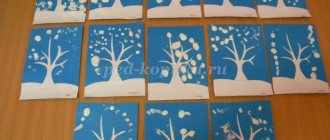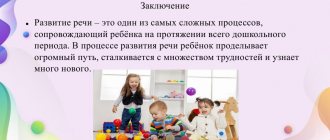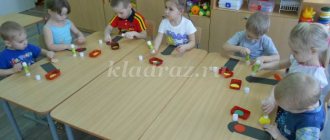Introduction to the natural world. First junior group (from 2 to 3 years old)
Introduction to the natural world.
First junior group (from 2 to 3 years old)
Introduce children to accessible natural phenomena.
Learn to recognize domestic animals (cats, dogs, cows, chickens, etc.) and their babies in nature, in pictures, and in toys, and to name them. Recognize some wild animals in the picture (bear, hare, fox, etc.) and name them.
Together with the children, watch the birds and insects on the site, and the fish in the aquarium; feed the birds.
Learn to distinguish vegetables (tomato, cucumber, carrot, etc.) and fruit (apple, pear, etc.) by appearance.
Help children notice the beauty of nature at different times of the year.
Cultivate a caring attitude towards animals. Teach the basics of interaction with nature (examine plants and animals without harming them; dress for the weather).
Visual material.
Didactic game “Take care of nature” for children of the younger group
The achievement of the first seven years is the formation of self-awareness: the child distinguishes himself from the objective world, begins to understand his place in the circle of close and familiar people, consciously navigate the surrounding objective-natural world, and isolate its values. During this period, the foundations for interaction with nature are laid; with the help of adults, the child begins to recognize it as a common value for all people. Therefore, I developed a didactic game for children in the younger group, aimed at developing a love for nature and the basic rules of behavior in nature. Didactic game “Take care of nature” for environmental education in the younger group. Goal: to form a kind attitude towards the natural world, responsiveness to communication with living beings, to consolidate the basic rules of behavior in nature “What not to do in nature.” Progress of the game: The teacher shows the picture to the children, tells what is depicted on it, and asks the children for their observations. And he explains what you shouldn’t do in nature, and how you should treat the living creatures that surround us.
“You can’t pick flowers from a flowerbed. Flowers need to be admired and cared for.”
“You can’t destroy birds’ nests. Touch birds' eggs with your hands."
“You cannot cut down young trees or break tree branches. Thanks to trees, we have clean air."
“You cannot catch butterflies and other insects. They die in captivity."
“You can’t destroy anthills.”
“You can’t light fires in nature. There could be a fire and many animals and plants could die.”
"You can't trample insects."
“You cannot touch wild animals and take them home. In captivity they die. And some of them can be harmful to health.”
Get text
Summary of a lesson on cognitive development “Take care of the forest, friends!” in the second junior group
Goal: To give children an initial concept of forest protection as a separate natural ecosystem.
Tasks:
Educational:
— to form in the minds of children the principles of ecological relationships with nature;
- teach to feel part of the ecological system;
— clarify and expand children’s existing ideas about the forest and its inhabitants;
— teach children to clearly, clearly, loudly answer questions using pictures and pronounce familiar words denoting an object and its purpose.
— teach to protect the forest (remind the rules of conduct in the forest).
Developmental:
— develop children’s motor activity;
- develop in children a cognitive interest in the life of the forest, its inhabitants, as well as memory, attention, thinking, coherent speech, and vocabulary on this topic;
- consolidate color, generalize children’s knowledge about wild animals and their habitat.
Educational:
- cultivate a caring attitude towards the environment;
- cultivate a love for nature and show care and attention to all living things.
Integration of areas:
Cognitive development, speech development, social and communicative development, physical development.
Equipment:
Blue fabric, hoop, cubes.
Sounds of the forest, birds, rain, joyful melody.
A picture of a tree without leaves and green leaves lying separately.
Toy: “Hedgehog”.
Pictures: hare, butterfly, bear, frog, sparrow, fish.
Pictures: “Rules of friends of nature.”
Cut pictures: rainbow, tree, forest, wolf, fox.
Umbrella.
Progress of the lesson:
V.: Guys, today we will go into the forest. We will see how amazingly beautiful it is in the forest, how wonderfully the birds sing. Let's say the magic words: “Turn around yourself, you will find yourself in a forest clearing!”
V.: Oh, look, someone is coming towards us. Who is this?
V.: This is a hedgehog.
V.: Why are you a hedgehog, so sad?
Y.: The tourists who came to my forest did not remove the garbage after themselves, burned a fire, cut down trees, and played loud music. And from all this, all the animals and birds ran away, and the forest lost its colors, everything became white and black.
V.: Maybe we can help you? Shall we help you guys?
Y.: Okay, but you will have to complete many tasks. Can you handle it?
V.: Guys, first we must show the Hedgehog that we can revive trees.
Q: Let's remember what time of year it is now? (Autumn.)
Q: What kind of trees are there now? (Bare, without leaves.)
V.: Well done, guys. And so we must help the trees become clothed again so that they don’t feel sad.
V.: Let's play the game: “Bring the tree to life” (Children come to the easel, take one green leaf at a time and put it on the branches of the tree.)
V.: Let's go further. Oh, guys, look, there's a lake here, but it's dirty. Let us clean it so that the water becomes clean.
Game: “Clean the Lake” . There is a blue cloth in the hoop with small cubes on it; children must take one cube at a time and put them in the basket.
V.: Well done guys! You have cleared the lake, now it is blue. When we swim in a lake or river or sea in the summer, we cannot throw anything into the water.
V.: Oh, guys, look. Someone scattered pictures, and the pictures are not simple. We need to look at these pictures and what we shouldn’t do in the forest.
Game: "Rules of Nature's Friends" . Children look at pictures depicting rules of behavior in the forest and name them.
V.: Well done.
V.: Guys, look, animals and birds left us a message. In order for them to return to the forest, we must perform the movements.
Game: “Guess what kind of animal?” Animals are drawn in the picture and children must show what kind of animal it is (a hare is jumping, a butterfly is flying smoothly, a bear is a bear with a clubfoot gait, a frog is jumping, a sparrow is flying, a fish is swimming).
V.: You did great. The animals and birds are grateful to you, now they will all return to the forest. Guys, when you come to the forest, you should not litter, do not offend animals and birds.
V.: Oh, guys, it looks like it’s going to rain, hurry up and run under your umbrella.
Game: "Rain". When rain music plays, children hide under an umbrella, when joyful music plays, children walk. Repeat 2-3 times.
V.: Guys, there is a bridge in front of us, we need to carefully cross it. Everyone crossed, no one fell?
D.: No.
V.: Guys, look, some ill-mannered children tore up a lot of pieces of paper and scattered them throughout the forest. Is it possible to throw litter in the forest?
D.: No.
V.: Let's collect all these pieces of paper and try to fold them.
Game: “Assemble the puzzles.” Cut pictures: rainbow, tree, forest, wolf, fox.
V.: Well done guys, you collected all the pictures.
V.: Look, the trees have become green, the sun has become yellow, the sky has become blue. We helped Hedgehog transform the forest, bring back its colors.
E.: Guys, did you remember that you can’t listen to music loudly in the forest so that animals and birds don’t get scared. You cannot litter; you must take your garbage with you and throw it in special containers.
E.: Goodbye!
V. and children: Goodbye!
V.: Guys, we’ve been in the forest with you, and now it’s time for you and me to return to the group. Let's say the magic words: “Turn around yourself, you will find yourself in kindergarten!” Here we are again in the group.
Lesson summary:
- Where did we go today?
-Who did we meet there?
— How should you behave in the forest?




